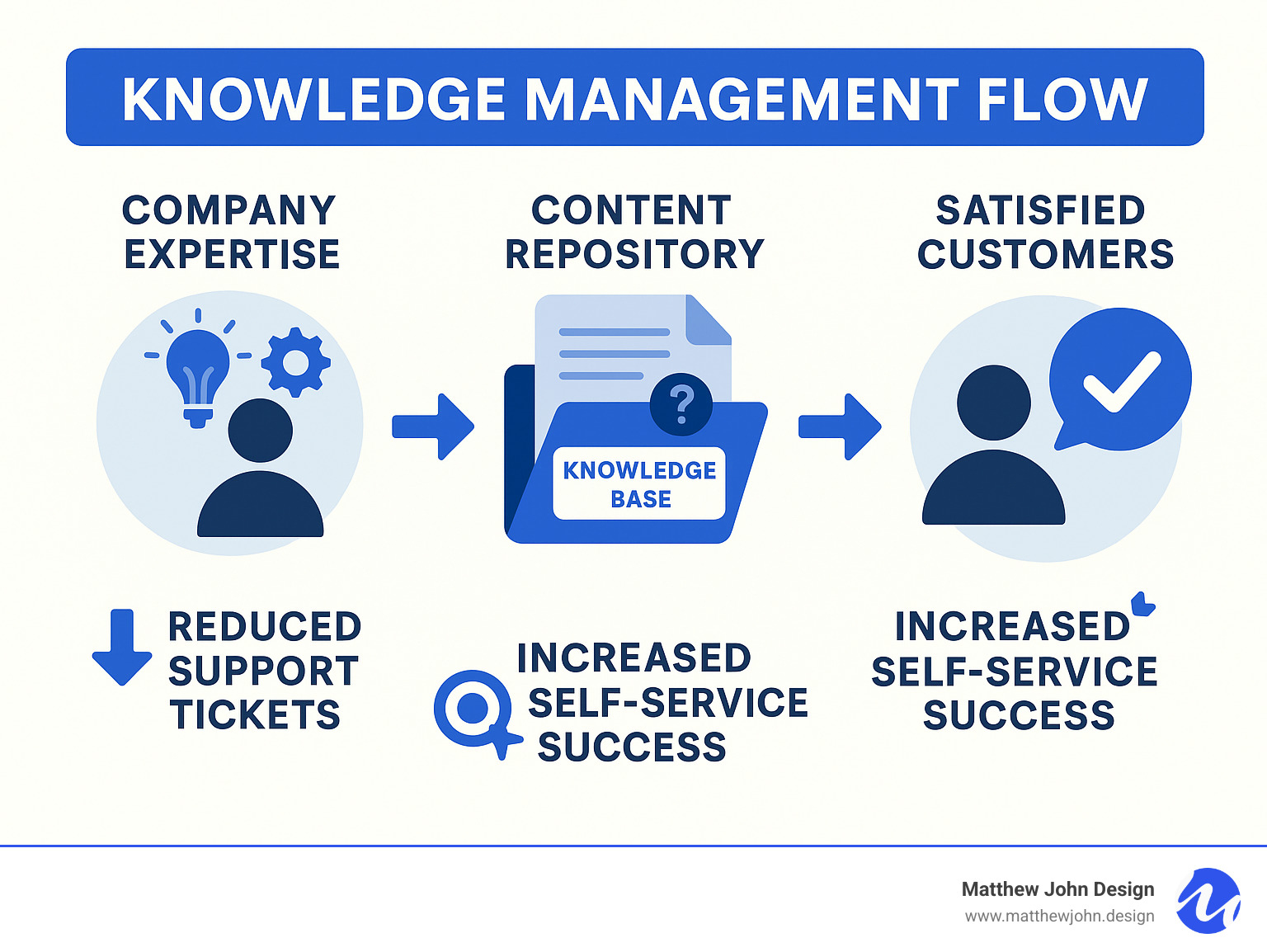Any information contained on this Website is not legal advice and should not be treated as such. You should always contact an attorney for help with your specific legal needs and issues. We may also earn a commission when you click links to our partners and purchase goods or services. For more information, read our Disclaimers Policy.
What Makes a Knowledge Base Essential for Modern Businesses
A knowledge base is a centralized digital repository that stores organized information, making it easily accessible to both customers and employees through self-service portals.
Quick Definition:
- Purpose: Self-serve information hub for instant answers
- Content: Articles, FAQs, guides, videos, and documentation
- Users: Internal teams (employees) and external users (customers)
- Benefit: 24/7 access to consistent, accurate information
In today's business environment, 73% of customers prefer to find solutions independently rather than contact support. Meanwhile, employees waste nearly 2 hours daily searching for information they need to do their jobs effectively.
This creates a massive opportunity. Companies with well-designed knowledge bases see up to 80% reduction in support calls while simultaneously boosting team productivity and customer satisfaction.
But here's what most businesses get wrong: they treat knowledge bases as simple document storage instead of strategic tools for growth. The difference between a basic FAQ page and a powerful knowledge management system can transform how your customers interact with their brand and how efficiently their team operates.
Whether you're looking to reduce support costs, improve customer experience, or streamline internal operations, understanding how to build and optimize a knowledge base becomes crucial for sustainable business growth.

What is a Knowledge Base? Core Components and Types
Think of a knowledge base as your company's digital brain – a smart system that doesn't just store information, but organizes it in a way that makes sense to real people looking for real answers.
Defining the Modern Knowledge Base
A modern knowledge base goes far beyond a simple document folder. It's a self-serve repository where information lives and breathes, constantly helping users find exactly what they need.
Picture walking into a perfectly organized library where every book, article, and resource is exactly where you'd expect it to be. That's what a well-built knowledge base feels like to your users.
The content inside typically includes articles that solve specific problems, FAQs that address common questions, step-by-step guides that walk users through processes, and video tutorials that show rather than just tell. You'll also find troubleshooting resources for when things go wrong and glossaries that explain industry terms in plain English.
The magic happens when users can find answers independently, without waiting for support tickets or hunting through email chains.
Knowledge Base vs. Database: A Critical Distinction
It's a common point of confusion, but the difference is critical. A database stores raw, structured data like customer records or transaction histories. It's built for reliability and retrieving specific data points. In contrast, a knowledge base is designed for understanding and context.
As Edward Feigenbaum explained, a database might store a patient's medical records, but a knowledge base contains the medical expertise to interpret them. It's built for reasoning and helping users draw meaningful conclusions from information.
The difference between a database and a knowledge base
Internal vs. External: Tailoring Knowledge for Different Audiences
The real power of a knowledge base shines when you design it for specific people with specific needs. This creates two distinct types that serve completely different purposes.

Internal knowledge bases become your team's secret weapon. These employee-only resources house everything from onboarding materials that get new hires up to speed quickly, to HR policies that answer those "wait, what's our vacation policy again?" questions. They're packed with standard operating procedures that ensure everyone follows the same best practices, plus company updates and technical documentation that keeps teams aligned.
When building scalable Webflow sites, a common practice is to create internal knowledge bases using Webflow's CMS. This lets marketing teams manage content seamlessly without constantly bothering developers. More info about Webflow Content Management System
External knowledge bases face outward, becoming your customers' go-to resource for self-service support. These customer-facing hubs contain product guides that explain features clearly, troubleshooting articles that solve common problems, and user manuals that turn confusion into confidence. The best ones make customers feel empowered rather than frustrated.
Both types rely on four essential components that make or break the user experience:
Search functionality acts as the front door – users need to find relevant information fast, whether through keyword searches, smart filters, or AI-powered natural language processing that understands how real people ask questions.
Content management happens behind the scenes but drives everything users see. This includes tools for creating, editing, and organizing articles, plus features like version control and article templates that maintain consistency.
Analytics tell the story of how your knowledge base actually performs. Which articles get the most views? What are people searching for but not finding? This data guides improvements that matter.
Feedback mechanisms close the loop by letting users rate articles or leave comments. This real-world input helps identify what's working and what needs attention, keeping your knowledge base accurate and genuinely helpful.
The Business Impact: Boosting Support and Productivity
When you implement a knowledge base properly, you're not just organizing information – you're changing how your entire business operates. The impact goes far beyond having a neat digital library; it directly addresses two critical business challenges: customers who demand instant answers and employees who spend way too much time hunting for information.
Revolutionizing Customer Support
Here's the reality: 72% of customers want immediate service, and 61% prefer self-service for simple issues. Your customers aren't just asking for faster support – they're telling you they'd rather solve problems themselves if you give them the right tools.
A well-designed external knowledge base becomes your customer support team's secret weapon. When customers can access information 24/7, they're no longer stuck waiting until business hours to resolve their issues. They can troubleshoot problems, learn about features, and find answers at 2 AM if they need to.
The ripple effect is remarkable. Companies typically see dramatic reductions in support tickets because customers are finding solutions independently. This isn't just about cutting costs – though that's certainly a benefit. It's about freeing up your support team to handle the complex, high-value conversations that actually require human expertise.
When customers find faster issue resolution through self-service, their satisfaction scores improve significantly. They get consistent answers every time, eliminating the frustration of receiving different information from different support agents. There's something deeply satisfying about being empowered to solve your own problems quickly.
Enhancing Employee Productivity
The internal benefits of a knowledge base are equally transformative, though often less obvious. McKinsey research shows that improved communication and collaboration through knowledge management technologies can raise the productivity of knowledge workers by 20-25%.
Think about how much time your team currently wastes searching for information. Studies reveal that employees lose close to two hours per day – that's 9.3 hours per week – just looking for the information they need to do their jobs. A searchable knowledge base cuts this waste dramatically.
Your knowledge base becomes a single source of truth for your organization. No more version confusion, no more asking around to find the latest procedure, no more wondering which document is actually current. Everyone works from the same accurate, up-to-date information.
New employee onboarding transforms when you have comprehensive training materials, HR policies, and company procedures readily accessible. Instead of overwhelming existing staff with constant questions, new hires can get up to speed independently while still knowing where to find help when they need it.
Perhaps most importantly, a knowledge base preserves your institutional knowledge. When experienced team members move on, their expertise doesn't walk out the door with them. You've captured and documented their insights for future use.
For remote teams like ours at Matthew John Design, this centralized knowledge hub becomes absolutely essential. Whether we're working on scalable Webflow sites or conversion funnel optimization, everyone stays aligned regardless of their location.

The bottom line? A knowledge base isn't just about organizing information – it's about creating a more efficient, empowered, and satisfied workforce while delivering the instant, consistent support your customers actually want.
How to Build and Maintain an Effective Knowledge Base
Building a knowledge base might seem overwhelming at first, but think of it like creating a helpful friend who's always available to answer questions. When we break it down into clear steps, the process becomes much more manageable and even exciting.

Step 1: Define Purpose and Plan Content
Before diving into writing, we need to get crystal clear on our "why" and "who." This foundation makes everything else fall into place naturally.
Start by identifying your audience – are you helping customers steer your products, or are you creating a resource for your team members? This decision shapes everything from your writing tone to the topics you'll cover. A customer-facing knowledge base might use friendly, simple language, while an internal one could include more technical jargon that your team already understands.
Next, analyze your support data like a detective looking for clues. Dig through those customer support tickets, chat logs, and the questions employees ask most often. What keeps coming up again and again? These repetitive questions are pure gold – they're telling you exactly what content will have the biggest impact.
Once you've identified these patterns, prioritize your topics ruthlessly. It's tempting to try covering everything at once, but starting with your most frequent pain points gives you quick wins. Define a clear scope for your initial launch – think of it as building the foundation before adding the fancy features.
Finally, set specific goals that you can actually measure. Instead of "make things better," try "reduce support emails by 25% in three months" or "cut new employee training time in half." These concrete targets keep you focused and help prove the value of your knowledge base.
Step 2: Create and Structure Your Content
Now comes the fun part – creating content that actually helps people. The secret is consistency and clarity, wrapped up in a format that's easy to digest.
Develop a writing style guide that feels like your brand's personality. At Matthew John Design, we keep things simple, clear, and warm because we want our clients to feel supported, not confused. Your knowledge base should sound like the helpful colleague everyone loves working with.
Article templates are your best friend here. Create standard formats for different content types – your how-to guides should follow one structure, while your troubleshooting articles follow another. This consistency helps users know what to expect and makes writing new content much faster.
Don't forget the power of visuals! Screenshots, diagrams, and short videos can explain complex processes better than paragraphs of text. Since most people learn visually, these elements make your knowledge base much more effective. When working with video content, Webflow only supports background videos up to 30 MB, so for larger instructional videos, you'll want to use YouTube, Vimeo, or Vidzflow for hosting.
Organize everything with logical categories that make sense to your users, not just to you. Think about how someone would naturally look for information. Internal linking between related articles creates a web of helpful connections and also boosts your content's search performance. Explore SEO Content Creation for more insights on creating findable content.
Step 3: Choose the Right Software and Tools
Selecting the right platform is like choosing the foundation for your house – it needs to support everything you'll build on top of it.
Look for key features like robust search functionality that actually finds what people need, intuitive content editing tools that don't require a computer science degree, analytics that show you what's working, and feedback mechanisms so users can tell you when something needs improvement.
Scalability matters more than you might think. Your knowledge base should grow with your business without requiring a complete rebuild. Consider how the platform will handle increasing content volume and user traffic as your company expands.
Integration capabilities can save you countless headaches. If your platform plays nicely with your existing CRM, customer support software, or other business tools, you'll create smooth workflows instead of frustrating bottlenecks. For businesses already using Webflow, leveraging the robust CMS capabilities with reusable components can create an efficient content management system that your marketing team can update independently.
Step 4: Launch, Promote, and Maintain
Building your knowledge base is just the beginning – the real magic happens when people start using it and it begins evolving based on their needs.
Publishing means making your knowledge base impossible to miss. For customer-facing resources, link prominently from your website, include it in email signatures, and mention it in automated support responses. The easier it is to find, the more it gets used.
Gathering user feedback shouldn't feel like pulling teeth. Make it simple for people to tell you what's helpful and what's missing. Sometimes the most valuable feedback comes from watching what people search for but can't find.
Regular content reviews keep your knowledge base fresh and accurate. Information changes quickly, and outdated content can frustrate users more than having no content at all. Schedule monthly or quarterly reviews to update existing articles and identify new topics to cover.
Analyzing usage metrics tells the real story of your knowledge base's effectiveness. Which articles get the most views? What search terms lead to dead ends? Where do people give up and contact support anyway? This data guides your ongoing content strategy and helps you focus your efforts where they'll have the most impact.
Continuous improvement is the name of the game. Your knowledge base should evolve constantly based on user needs, business changes, and new insights. The best knowledge bases are never "finished" – they're always growing and getting better.
The Evolution of Knowledge Management: AI and Optimization
The knowledge base has come a long way from its humble beginnings as a simple file cabinet of documents. What started as static repositories have evolved into intelligent, dynamic systems that learn and adapt to user needs. This change has been largely driven by artificial intelligence and a deeper understanding of user experience.
The Role of AI in the Modern Knowledge Base
Artificial intelligence is fundamentally changing how we create, manage, and interact with knowledge bases. It's like having a brilliant assistant who never sleeps and gets smarter with every interaction.
AI-powered search represents perhaps the biggest leap forward. Instead of forcing users to guess the right keywords, modern systems understand natural language queries. When someone types "Why isn't my video working?" the system knows they're likely looking for troubleshooting content, even if the articles use terms like "playback issues" or "media display problems." This intuitive approach makes finding answers feel effortless rather than frustrating.
Generative AI for content creation is revolutionizing how teams build their knowledge bases. AI can draft initial versions of articles, expand on existing content, or help rewrite complex technical information in simpler terms. This doesn't replace human expertise but amplifies it, allowing teams to focus on refining and perfecting content rather than starting from scratch. Find AI-Driven SEO Content Creation explores how this technology can improve your content strategy.
Perhaps most importantly, AI excels at identifying content gaps. By analyzing user search patterns and support ticket themes, AI can pinpoint exactly where your knowledge base needs attention. It might notice that people frequently search for "mobile app login issues" but your current articles only cover desktop login problems.
Chatbot integration creates a seamless bridge between users and your knowledge base. Modern chatbots don't just provide scripted responses; they pull relevant information directly from your articles, creating personalized answers that feel natural and helpful. It's like having a knowledgeable team member available 24/7 who never gets tired of answering the same question.
Best Practices for Searchability and User Experience
Even the most comprehensive knowledge base fails if users can't find what they need quickly and easily. The key is treating every article like a valuable piece of real estate that needs to be both findable and welcoming.
SEO optimization ensures your external knowledge base articles appear in search results when customers need them most. This means incorporating relevant keywords naturally into titles and content, writing compelling meta descriptions that encourage clicks, and using clean, descriptive URLs that both users and search engines can understand. Strategic internal linking between related articles helps users find additional helpful information while strengthening your site's overall search performance. Webflow Blog SEO best practices provides detailed guidance on optimizing your content for search engines.
Creating skimmable content respects your users' time and attention. People don't want to read novels when they need quick answers. Short paragraphs, clear headings, bullet points where appropriate, and strategic use of bold text for key information help users find exactly what they need without getting lost in walls of text.
Mobile-first design isn't optional anymore. Most people will access your knowledge base on their phones, often while they're frustrated and looking for immediate solutions. The experience needs to be smooth and intuitive on every device, from the smallest smartphone screen to the largest desktop monitor.
Clear navigation acts as your users' roadmap. Intuitive menus, helpful breadcrumbs, and suggestions for related articles keep people engaged and help them find solutions they didn't even know they were looking for.
The magic happens when all these elements work together seamlessly. Users arrive with questions, find answers quickly, and leave feeling empowered rather than frustrated. This kind of positive experience builds trust and loyalty while reducing the burden on your support team.

Frequently Asked Questions about Knowledge Bases
When we talk with businesses about implementing a knowledge base, certain questions come up again and again. Let's explore the most common ones to help you understand how this powerful tool can work for your organization.
What's the difference between a knowledge base and an intranet?
An intranet is a broad internal hub for company news, directories, and general resources. It connects employees and provides access to company-wide services. A knowledge base is more focused. It's a specialized library of organized, searchable information designed to solve specific problems and answer targeted questions. While often integrated into an intranet, its core purpose is delivering expertise and solutions, not general communication.
What content should be included in a knowledge base?
The content in your knowledge base should directly address the questions your audience asks most frequently. For external knowledge bases serving customers, this means focusing on product guides, troubleshooting steps, and service explanations. For internal ones supporting employees, think onboarding materials, company procedures, and technical documentation.
The most effective knowledge bases include frequently asked questions with detailed answers, step-by-step how-to guides, and troubleshooting articles that walk users through common problems. Video tutorials work exceptionally well because they show rather than just tell – though remember that Webflow only supports background videos up to 30 MB, so you'll want to use YouTube, Vimeo, or Vidzflow for hosting longer instructional videos.
Don't forget about product documentation, glossaries of industry terms, and best practice guides. For internal knowledge bases, policy documents and release notes become crucial additions. The goal is creating a comprehensive resource that anticipates what users need before they even ask.
Visual content like screenshots, diagrams, and short demonstration videos can transform complex explanations into easily digestible information. When building these resources in Webflow, we often leverage reusable components to maintain consistency across all knowledge articles.
How do you measure the success of a knowledge base?
Measuring success starts with understanding what problems your knowledge base was designed to solve. The most telling metric is the case deflection rate – essentially, how many people find their answers without needing to contact support. When this number climbs, you know your knowledge base is doing its job.
Time to resolution tells another important story, especially for internal knowledge bases. When employees can find information faster, productivity naturally increases. We also track customer satisfaction scores through simple article ratings, which reveal whether content truly helps users or leaves them frustrated.
Article view counts and search success rates provide insight into user behavior. High view counts on certain articles might indicate popular topics that deserve expansion, while low search success rates could signal missing content or poor organization.
Pay close attention to top search queries – they're like a direct line to your users' minds, showing you exactly what they're trying to find. When you notice patterns in unsuccessful searches, that's your cue to create new content or improve existing articles.
The feedback doesn't stop at numbers. Direct user feedback through ratings and comments provides qualitative insights that metrics alone can't capture. Regular content reviews ensure your knowledge base stays current and continues serving its purpose effectively.
A successful knowledge base evolves constantly. The metrics guide improvements, but the real measure of success is whether your users – customers or employees – feel empowered to find answers independently.
Conclusion
We've journeyed through the intricate world of the knowledge base, from its origins in computer science to its modern-day applications as a cornerstone of efficient business operations. What started as a simple question about organizing information has revealed itself to be one of the most powerful tools for changing how businesses serve their customers and empower their teams.
The change is remarkable when you think about it. A well-structured knowledge base isn't just a digital filing cabinet gathering virtual dust. It's a living, breathing system that works around the clock, answering questions, solving problems, and freeing up your team to focus on what truly matters.
The numbers speak for themselves: 72% of customers want immediate service, and a robust knowledge base delivers exactly that. Meanwhile, your support team gets breathing room to tackle complex issues, your employees stop wasting hours hunting for information, and your customers feel genuinely empowered to solve their own problems.
But here's what excites us most about knowledge bases: they embody the same principles we live by at Matthew John Design. Just like how we create scalable Webflow sites with reusable components and intuitive CMS structures, a great knowledge base is all about making information accessible, organized, and user-friendly. When marketing teams can launch pages without developer delays, and when customers can find answers without support tickets, everyone wins.
The future looks even brighter with AI integration making search more intuitive and content creation more efficient. We're moving toward a world where finding the right information feels as natural as having a conversation with a knowledgeable friend.
Whether you're drowning in support tickets or watching your team struggle to find basic information, investing in a knowledge base isn't just smart—it's essential. It's about creating an environment where both customers and employees feel supported, informed, and empowered to succeed.
Your knowledge base becomes more than a repository; it becomes a strategic business asset that grows more valuable over time. Every article added, every search improved, and every satisfied user contributes to a cycle of continuous improvement that benefits everyone.
Ready to transform your scattered information into an empowering resource that actually gets used? We understand the art of creating content that not only informs but engages and converts. Get expert SEO Writing and Video services and let's build something amazing together—because great content deserves a great home.

